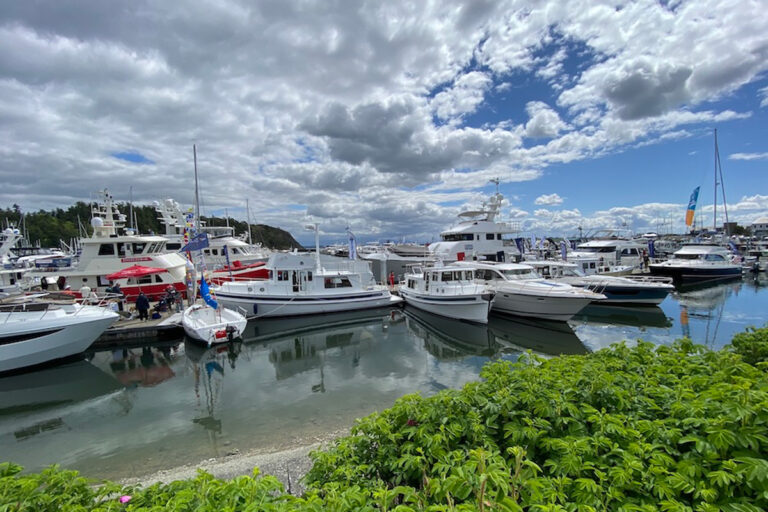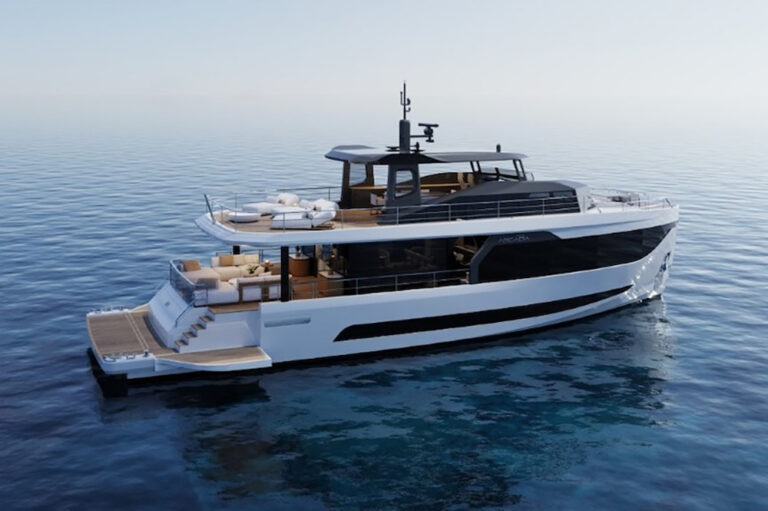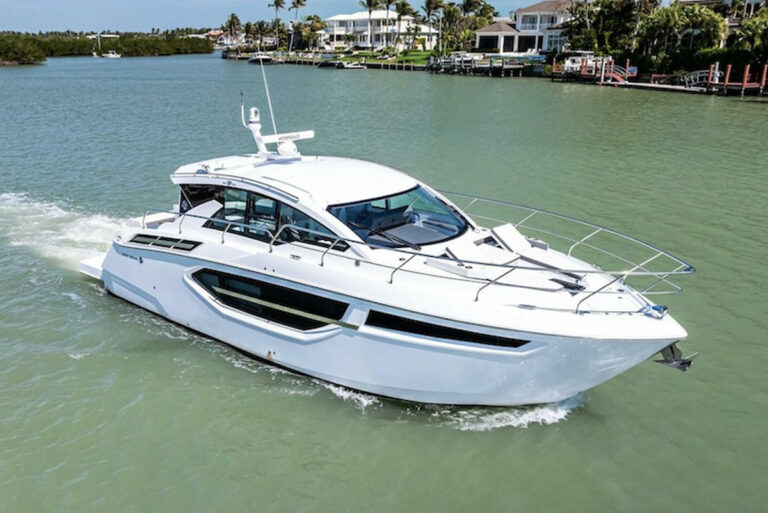
ytgjul09cy2525.jpg
I was anchored in Block Island’s Great Salt Pond when my VHF came alive with a frantic call. “Hey, Harry! I don’t know what’s wrong! I dropped the anchor until it hit bottom and then tied it real tight! But I keep drifting!” This is a true story, and it is just one of the many anchoring antics I witnessed that weekend.
Of course, if you have never dragged anchor or been part of an anchoring mishap, you’ve probably spent more time at marinas than on the hook. But if that’s true, you’ve missed one of the best parts of boating-being away from the noise and hubbub of a busy marina and enjoying the peace and quiet of your natural surroundings.
Here are five tips to help get a firm hold on your chosen spot and to ensure a good night’s sleep, even when the wind and seas pick up.
1. Choosing Your Ground Tackle. There are many opinions about what type of anchor works best in different kinds of bottom, such as sand, mud, or rocks. Over the years, one of the most reliable designs has been the plow, or variations of it. These would include the ubiquitous CQR and increasingly popular Delta. Personally I have experienced excellent results with the Spade, a lightweight variation of the plow. It has never failed to set, even over grassy areas where my CQR could not get a firm hold.
A new generation of designs, including the Rocna, has been getting rave reviews. The lightweight, aluminum Danforth-type Fortress is also an excellent choice, especially as a backup anchor that can be stowed below until it’s needed. Most important, choose an anchor big enough for your boat. This is the last place you should choose to save money, so if your boat’s bow can handle it, go for at least one size bigger than is recommended.
An all-chain rode is great if your boat can carry the weight forward. The weight of the chain will help set your anchor quickly, rocks or coral will not cut it, and you’ll need less scope than with nylon rode. But consider that 300 feet of 5/16-inch chain weighs 300 pounds, so you’ll definitely need a windlass to raise your anchor. As a compromise, I have found that 50 feet of chain spliced to 250 feet of 5/8-inch nylon rode is an ideal combination for my 43-foot, 22,000-pound powerboat. While benefiting from many of the advantages of having an all-chain rode, I avoid the 250 pounds that my bow would have to carry.
2. Getting a Good Set. Unlike the fellow on Block Island, you’ll want to let out enough line to create a scope of at least 3:1, or three times more length than the depth of the water you’re in. Ten feet of water? Thirty feet of line measured from where it enters the water. But that’s the absolute minimum. Where there’s enough swinging room, 5:1 is recommended, and if you’re expecting a real blow, consider 10:1. But be sure you won’t swing into other boats anchored nearby when the wind or tide shifts. If a storm is coming in a crowded anchorage, ask your nearest neighbors how much scope they have out and discuss contingency plans in case all hell breaks loose.
Get your anchor well set before turning off your engine. You’ll normally want to work as a team with one person at the helm and one at the anchor near the windlass controls. Decide on a system of hand signals that tell the helmsperson what to do. Most of us have witnessed embarrassing episodes of a macho man standing on the bow screaming conflicting directions to his hapless mate who is unable to hear anything except for an occasional four-letter command-often returned by a single-finger signal. Some couples use wireless headsets to communicate, but that seems unnecessary compared to simple hand signals (forward, neutral, reverse, to port, to starboard, shut down, open the beer).
While letting out your rode, gradually move your boat aft, or downstream, so that the chain or nylon rode doesn’t pile up on top of itself. When you’ve reached at least 3:1 scope, secure the rode and gently back down, watching the rode or chain to see if it pulls tight. If the rode alternately pulls tight and then loosens, your anchor is skipping, and you need to reset. Pick a spot on land or a nearby marker as a reference point to make sure you’re not moving aft as you back down. When set, let out even more scope if you can, and predict where your boat will swing if the tide or wind shifts. Back down again at this scope, making sure your anchor is well set before turning off your engine and leaving your boat.
3. When Two Anchors Are Better Than One. If you find yourself in a narrow strip of waterway with a significant current, beware of the path your boat will take when it swings 180 degrees as the tide changes. Factoring in your scope, you may find yourself dangerously close to shore or up against a nearby boat. The solution is to deploy two anchors from the bow set 180 degrees apart, which will limit the boat’s swing to a circle of about two boat lengths. This “Bahamian style” of anchoring takes some practice to prevent wrapping an anchor rode around your prop. Drop the first anchor upstream, drift back and set the anchor as usual. Now let out a total of twice the normal scope and drop the second anchor, also from the bow. Then pull up on the first rode while letting out the second rode to a point equidistant from both anchors. Be careful not to foul the second rode in your prop as you move to the middle position. Leave just enough slack on the non-working rode to allow it to sink below your boat. With both lines secured to the bow, the boat will pivot in place as the tide changes.
To keep your bow pointed into a swell or high wind, drop a stern anchor. Set your bow anchor as you would normally, then let out twice your scope and drop your stern anchor. Pull up on your bow rode to a point equidistant from both anchors and secure the stern line to an aft cleat. For occasional stern anchoring situations, a lightweight anchor such as a Fortress is ideal because you can keep it stowed aft, along with an extra rode and short length of chain. This technique works well except in situations where you’ll experience a strong wind or current abeam. In these cases you’ll find yourself in an uncomfortable, if not unsafe, position. It’s best to lie on one anchor in these situations.
In anticipation of a real blow, setting two bow anchors at an angle of between 45 degrees and 35 degrees from each other can greatly increase your holding power. After setting the first anchor, motor up abreast of it, being careful not to let the rode go slack and slip under your vessel. Drop the second anchor and fall back until both lines are of equal length and secure them to the bow.
4. Weighing Anchor. Normally this is an easy, straightforward procedure. While you’re warming up your engine, make sure your windlass circuit breakers are on, and if you have a washdown system, turn it on and get your hose ready. Reduce the strain on your windlass by slowly motoring forward as you raise your anchor. Don’t attempt to move your boat forward with a relatively small windlass motor. Again, use hand signals so your mate knows what to do at the helm. Wash the mud and sand off the anchor before it finds its way to your deck or into your chain locker.
Before throttling up to cruising speed, be sure your anchor is secured properly in its chocks or roller, a chain stopper is engaged, and the windlass is locked. My anchor once jumped off its roller and went overboard with 50 feet of chain as I was trying to escape an anchorage with six-foot breakers during a sudden squall. I now tie a separate, small line from the shank of each anchor to a bow cleat as an extra precaution.
If your anchor becomes stuck on the bottom, shorten scope and position your bow directly above it. Slowly move forward and try to raise it. If it doesn’t break loose, let out a little scope and start circling it while keeping the rode tight. Oftentimes a slightly different angle will dislodge it. If it’s still stuck, try positioning the boat in the opposite direction in which you were anchored, let out more scope and back down. The force of pulling in the opposite direction should be enough to dislodge it.
Before anchoring over a rocky bottom that may foul your anchor, consider adding a light “buoyed trip line” to the crown of the anchor. Many anchors provide an eye for this purpose. The line should be slightly longer than the water’s depth and secured to a floating buoy. If stuck, hauling on the trip line should dislodge the crown first.
5. Other Tips and Cautions. Without depth markers on your anchor rode, it’s impossible to tell how much scope you’ve let out. Paint a series of color strips on your chain to indicate specific depths. For your nylon rode, insert those little plastic numbered strips available at any marine supply store or tie pieces of small-diameter cord at 20- or 25-foot intervals.
If you’re using all chain, you’ll want to attach a bridle or a short section of nylon rode (5 feet of nylon tied between 6 feet of chain will do the trick) to act as a shock absorber when the boat pitches or pulls back. Secure the rode or bridle through chocks and onto an appropriate set of cleats, taking the pressure off your windlass. Add anti-chafing gear to the lines if you plan to be there for more than a few hours.
If you’re using a nylon rode and can’t put out as much scope as you’d like because you’re in a tight area, consider adding a “sentinel,” or heavy weight, to your anchor line. In a pinch, you can use a smaller, lightweight anchor. Twenty-five pounds or so will work. Attach the weight to the rode with a shackle so it can slide down the anchor line towards the bottom. Tie a small line to the weight and send it down more than halfway to your main anchor. The added weight will lower the angle of pull and increase your holding power.
When entering an anchorage, understand that boats already anchored have prior claim to their space, including their anticipated swinging room. Don’t expect them to move if you find yourself too close later in the day. For ease of mind overnight, set the anchor alarm on your GPS, if it’s so equipped. And be sure to turn on your anchor light if you’re not in a specially designated anchorage area.
Each boat and set of ground tackle has its own characteristics. You’ll want to practice anchoring in a nonthreatening environment until the entire process becomes second nature. And for everyone’s benefit, no yelling. Use those hand signals.









